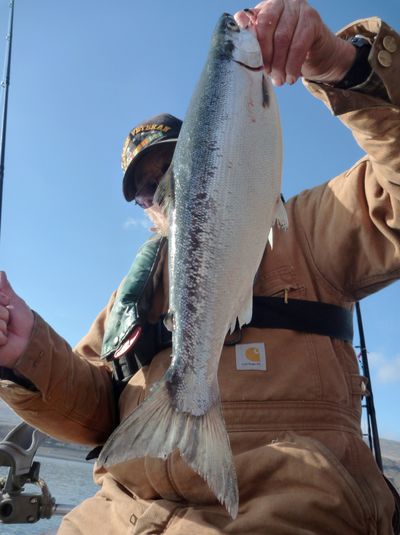Rich Landers: Wild kokanee drive the limit at Lake Roosevelt

Thanks to Idaho, Anglers have been hooking a bumper crop of kokanee in Lake Roosevelt since last year. Unfortunately, they’ve had to release most of the delicious land-locked sockeyes.
“Almost every one we catch has an unclipped adipose fin,” said Clarence Rief, a Davenport-area kokanee enthusiast, who said he’s concerned about the waste.
“We can keep only fin-clipped hatchery kokanee. But I know a lot of those fish we’re releasing don’t survive.”
Colville Tribe biologists have tested and linked the increase of kokanee in Roosevelt to the rebound of Lake Pend Oreille kokanee, which are unmarked.
Fishermen can keep up to five kokanee a day from the Roosevelt, the Columbia River reservoir behind Grand Coulee Dam, but only two of them can be unmarked.
(Workers clip the adipose fins off hatchery fish before they’re released.)
The rule was established to protect Roosevelt’s wild strain of kokanee, said Chris Donley, Washington Department of Fish and Wildlife inland lakes manager.
The situation is similar to restrictions on fishing for salmon and steelhead elsewhere in the region.
“We want hatchery fish to be caught, but we have to regulate to protect the wild fish,” he said.
Rief caught Washington’s record kokanee, 6.25 pounds, from Roosevelt in 2003. But the kokanee fishery has had many ups and downs since then.
Net-pen releases of kokanee ended around 2005 in favor of direct releases from the Spokane Tribal Hatchery.
Production of kokanee from the tribal hatchery has been dramatically reduced in recent years, from about 500,000 in 2010 to about 200,000 in 2013.
Last year, no kokanee were produced and released into Roosevelt because of a disease outbreak, said hatchery manger Tim Peone.
This year, about 85,000 kokanee will be raised, fin-clipped and released, he said.
“When we were releasing smaller fish, predators like walleye and bass got most of them,” Peone said.
“By raising fewer fish to larger sizes – four to a pound this year – we hope to get more fish into the angler creel.”
This year marks a new program in which the hatchery kokanee will be“triploids,” that is, sterile. Peone said this should help them grow larger faster and be more resistant than previous hatchery fish to following their sea-running instincts and heading downstream through Grand Coulee Dam.
“These fish will be released at Fort Spokane-Seven Bays area and will be showing up in angler harvest by July,” he said.
“Our goal is for 100 percent harvest. We want these fish to be caught.”
Less emphasis on kokanee stems from years of research showing that Roosevelt kokanee are a poor investment of fisheries mitigation funding from the Bonneville Power Administration for impacts caused by Grand Coulee Dam.
Changes in dam operations have increased drawdowns in many years, leaving the eggs of naturally spawning kokanee high and dry.
Hatchery kokanee were found to be significantly impacted by predators or flushed downstream. The money is better spent, researchers say, on raising rainbow trout in net pens.
But some hatchery kokanee effort continues because the tribes have a cultural link to salmon and the fish support other wildlife. In addition, anglers love to catch and eat them.
The increase of kokanee in Lake Roosevelt starting last year is the result of kokanee restoration in Lake Pend Oreille as well as good numbers at Lake Coeur d’Alene, Donley said.
Fish researchers working with the Colville Tribe have been able to link fish from the big schools in Roosevelt to upstream Idaho sources, he said.
“They’re not the big 19- to 21-inch kokanee that Roosevelt anglers are used to,” he said. “They’re smaller fish, running 14-16 inches.
“There’s a lot of them. Good fishermen can catch 20 a day and they’d like to keep more of them, but the Idaho fish are unclipped.
“If we had a way for anglers to positively ID the Idaho fish, we’d let them keep more of them, but we have to protect the Lake Roosevelt-origin wild kokanee.”
Donley said he understands the frustration of anglers who catch mostly unclipped kokanee.
“I went through it while fishing this winter, too,” he said. “We’d get into massive schools where we could catch kokanee at will, but it’s no different than Puget Sound chinook: the number of wild fish – the lowest abundance stock – drives the limit.
“There are more kokanee in Roosevelt than we’ve seen in a long time. Only a fraction are marked.”
Limits could be changed, possibly on the basis of size, if this year’s abundance of kokanee became consistent, Donley said.
“But this could be just a one- or two-year event,” he said.
Responding to anglers who say the kokanee they release aren’t surviving, Donley is direct: “Catch two kokanee and stop,” he said. “Go on to other fish. If it’s in the summer and you’re going deep to catch kokanee, troll closer to the surface after you catch two unclipped kokanee and you’ll be in the rainbow zone.”
The challenge for fisheries managers is getting anglers to value the fishery as it is. The option is a flat two-kokanee limit, as it is downstream in Lake Rufus Woods.
“You can reduce hooking mortality on kokanee by releasing them in the water and avoiding a net which just knocks scales off,” Donley said.
“But the best way conserve what we have is to catch two and stop.”